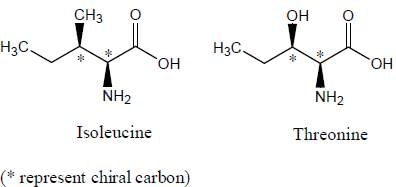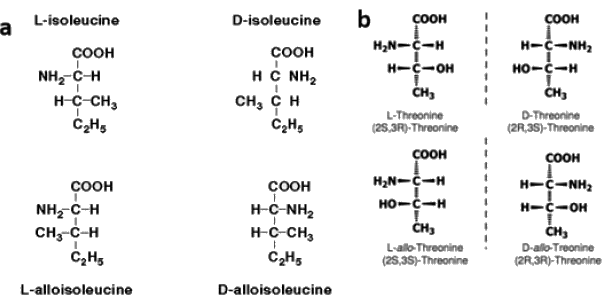IIT JAM Exam > IIT JAM Questions > Which of the following amino acids will have ...
Start Learning for Free
Which of the following amino acids will have Diastereomers.
- a)Isoleucine
- b)Threonine
- c)both (a) and (b)
- d)None
Correct answer is option 'C'. Can you explain this answer?
Verified Answer
Which of the following amino acids will have Diastereomers.a)Isoleucin...
Stereoisomers that are mirror images of each other are called enantiomers.
Stereoisomers that are not mirror images of each other are called diastereomers.
Diastereomers are present only in those molecules which have more than one chiral carbon atoms, and isoleucine as well as threonine both have two chiral centers. Since both threonine and isoleucine have two chiral centres each, maximum number of stereoisomers in each case will be 2n = 22 = 4 (n is the number of chiral centres).


Stereoisomers that are not mirror images of each other are called diastereomers.
Diastereomers are present only in those molecules which have more than one chiral carbon atoms, and isoleucine as well as threonine both have two chiral centers. Since both threonine and isoleucine have two chiral centres each, maximum number of stereoisomers in each case will be 2n = 22 = 4 (n is the number of chiral centres).


Most Upvoted Answer
Which of the following amino acids will have Diastereomers.a)Isoleucin...
Diastereomers are stereoisomers that are not mirror images of each other and have different physical and chemical properties. In the case of amino acids, the presence of a chiral carbon (except for glycine) allows for the existence of stereoisomers.
a) Isoleucine:
Isoleucine is an amino acid with four different substituents attached to its chiral carbon. Therefore, it can exist as two stereoisomers: L-isoleucine and D-isoleucine. These two stereoisomers are non-superimposable mirror images and are therefore enantiomers. Since they are not mirror images of each other, they are also diastereomers.
b) Threonine:
Threonine is another amino acid that has a chiral carbon. It can exist as four stereoisomers: L-threonine, D-threonine, L-allo-threonine, and D-allo-threonine. L-threonine and D-threonine are enantiomers, while L-allo-threonine and D-allo-threonine are also enantiomers. However, L-threonine and L-allo-threonine, as well as D-threonine and D-allo-threonine, are diastereomers since they are not mirror images of each other.
c) Both (a) and (b):
Both isoleucine and threonine have chiral carbons, allowing for the existence of stereoisomers. Isoleucine has two stereoisomers (L-isoleucine and D-isoleucine), which are enantiomers and diastereomers. Threonine has four stereoisomers (L-threonine, D-threonine, L-allo-threonine, and D-allo-threonine), with L-threonine and L-allo-threonine, as well as D-threonine and D-allo-threonine, being diastereomers.
d) None:
Since both isoleucine and threonine have chiral carbons and can exist as stereoisomers, the correct answer is option 'C' - both (a) and (b).
a) Isoleucine:
Isoleucine is an amino acid with four different substituents attached to its chiral carbon. Therefore, it can exist as two stereoisomers: L-isoleucine and D-isoleucine. These two stereoisomers are non-superimposable mirror images and are therefore enantiomers. Since they are not mirror images of each other, they are also diastereomers.
b) Threonine:
Threonine is another amino acid that has a chiral carbon. It can exist as four stereoisomers: L-threonine, D-threonine, L-allo-threonine, and D-allo-threonine. L-threonine and D-threonine are enantiomers, while L-allo-threonine and D-allo-threonine are also enantiomers. However, L-threonine and L-allo-threonine, as well as D-threonine and D-allo-threonine, are diastereomers since they are not mirror images of each other.
c) Both (a) and (b):
Both isoleucine and threonine have chiral carbons, allowing for the existence of stereoisomers. Isoleucine has two stereoisomers (L-isoleucine and D-isoleucine), which are enantiomers and diastereomers. Threonine has four stereoisomers (L-threonine, D-threonine, L-allo-threonine, and D-allo-threonine), with L-threonine and L-allo-threonine, as well as D-threonine and D-allo-threonine, being diastereomers.
d) None:
Since both isoleucine and threonine have chiral carbons and can exist as stereoisomers, the correct answer is option 'C' - both (a) and (b).

|
Explore Courses for IIT JAM exam
|

|
Question Description
Which of the following amino acids will have Diastereomers.a)Isoleucineb)Threoninec)both (a) and (b)d)NoneCorrect answer is option 'C'. Can you explain this answer? for IIT JAM 2025 is part of IIT JAM preparation. The Question and answers have been prepared according to the IIT JAM exam syllabus. Information about Which of the following amino acids will have Diastereomers.a)Isoleucineb)Threoninec)both (a) and (b)d)NoneCorrect answer is option 'C'. Can you explain this answer? covers all topics & solutions for IIT JAM 2025 Exam. Find important definitions, questions, meanings, examples, exercises and tests below for Which of the following amino acids will have Diastereomers.a)Isoleucineb)Threoninec)both (a) and (b)d)NoneCorrect answer is option 'C'. Can you explain this answer?.
Which of the following amino acids will have Diastereomers.a)Isoleucineb)Threoninec)both (a) and (b)d)NoneCorrect answer is option 'C'. Can you explain this answer? for IIT JAM 2025 is part of IIT JAM preparation. The Question and answers have been prepared according to the IIT JAM exam syllabus. Information about Which of the following amino acids will have Diastereomers.a)Isoleucineb)Threoninec)both (a) and (b)d)NoneCorrect answer is option 'C'. Can you explain this answer? covers all topics & solutions for IIT JAM 2025 Exam. Find important definitions, questions, meanings, examples, exercises and tests below for Which of the following amino acids will have Diastereomers.a)Isoleucineb)Threoninec)both (a) and (b)d)NoneCorrect answer is option 'C'. Can you explain this answer?.
Solutions for Which of the following amino acids will have Diastereomers.a)Isoleucineb)Threoninec)both (a) and (b)d)NoneCorrect answer is option 'C'. Can you explain this answer? in English & in Hindi are available as part of our courses for IIT JAM.
Download more important topics, notes, lectures and mock test series for IIT JAM Exam by signing up for free.
Here you can find the meaning of Which of the following amino acids will have Diastereomers.a)Isoleucineb)Threoninec)both (a) and (b)d)NoneCorrect answer is option 'C'. Can you explain this answer? defined & explained in the simplest way possible. Besides giving the explanation of
Which of the following amino acids will have Diastereomers.a)Isoleucineb)Threoninec)both (a) and (b)d)NoneCorrect answer is option 'C'. Can you explain this answer?, a detailed solution for Which of the following amino acids will have Diastereomers.a)Isoleucineb)Threoninec)both (a) and (b)d)NoneCorrect answer is option 'C'. Can you explain this answer? has been provided alongside types of Which of the following amino acids will have Diastereomers.a)Isoleucineb)Threoninec)both (a) and (b)d)NoneCorrect answer is option 'C'. Can you explain this answer? theory, EduRev gives you an
ample number of questions to practice Which of the following amino acids will have Diastereomers.a)Isoleucineb)Threoninec)both (a) and (b)d)NoneCorrect answer is option 'C'. Can you explain this answer? tests, examples and also practice IIT JAM tests.

|
Explore Courses for IIT JAM exam
|

|
Signup for Free!
Signup to see your scores go up within 7 days! Learn & Practice with 1000+ FREE Notes, Videos & Tests.























